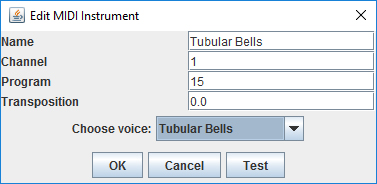JMSL Tutorial: Instruments and Interpreters
MIDI
JMSL supports JavaSound MIDI. With Java 7 onwards, JavaSound's "Gervill" implementation supports high quality SoundFonts!Here's how to set up Midi:
JMSL.midi = new MidiIOFactory().getMidiIO(MidiIOFactory.MidiIO_JAVASOUND);
((MidiIO_JavaSound) JMSL.midi).setSoundbankFile(new File(LOCATION_OF_SOUNDFONT));
JMSL.midi.setOutDevice("Gervill");
JMSL.midi.open();
You do not have to specify the location of a Soundfont file. JavaSound will use a default if none is specified or if the file is not found.
 JMSL's Midi device editor will let you browse for a soundfont. Download the FluidR3 GM2-2.SF2 here. |
 JMSL's Midi Instrument Editor allows you to interactively choose Midi channel, program change, transposition, and instrument name. A dropdown list of General Midi instruments is generated from the loaded SoundFont, which sets the Program Change. |
Below is complete source for a simple application that uses JavaSound MIDI, opens the Midi Device editor, then starts playing a MusicShape with a Midi Instrument. While it is playing, a Midi Instrument editor is displayed. You can hear different voices while it is performing by choosing from the drop-down list. This sets the instrument's MIDI Program Change.
package jmslexamples.simple;
import java.awt.event.WindowAdapter;
import java.awt.event.WindowEvent;
import java.io.File;
import java.io.IOException;
import javax.swing.JFrame;
import javax.swing.JLabel;
import com.softsynth.jmsl.*;
import com.softsynth.jmsl.midi.*;
import com.softsynth.jmsl.view.MidiInstrumentEditDialog;
/**
* Just play a MusicShape with a Midi instrument.
*
* This demo opens a Midi Device Editor.
* It also opens Midi Instrument Editor which you can play with while the MusicShape is performing;
*
* SoundFont support! As of Java 1.7 uses Gervill JavaSound. This demo uses FluidR3 soundfont. If
* you don't have it, it will use Java's default sounds. You can download the FluidR3 SoundFont at
* http://www.algomusic.com/SoundFonts/
*
* @author Nick Didkovsky, (c) 2016 All rights reserved
*
*/
public class MIDISimple extends JFrame {
// change this if you have a preferred MIDI sound font!
// If this file is not found, MidiIO_JavaSound will try to load a default soundbank.
// You can download the FluidR3 SoundFont at http://www.algomusic.com/SoundFonts/
String LOCATION_OF_SOUNDFONT = "F:/jwork/SoundFonts/FluidR3/FluidR3 GM2-2.SF2";
JMSLMixerContainer mixer;
MidiInstrument instrument;
MusicShape musicShape;
public void go() {
initJavaSoundMidi();
buildMixer();
buildInstrument();
buildSong();
launchSong();
openMidiInstrumentEditor();
}
private void openMidiInstrumentEditor() {
MidiInstrumentEditDialog d = new MidiInstrumentEditDialog(instrument);
d.setVisible(true);
}
private void initJavaSoundMidi() {
try {
JMSL.midi = new MidiIOFactory().getMidiIO(MidiIOFactory.MidiIO_JAVASOUND);
((MidiIO_JavaSound) JMSL.midi).setSoundbankFile(new File(LOCATION_OF_SOUNDFONT));
JMSL.midi.setOutDevice("Gervill");
JMSL.midi.edit(this);
JMSL.midi.open();
} catch (IOException e2) {
e2.printStackTrace();
}
}
private void buildMixer() {
mixer = new JMSLMixerContainer();
mixer.start();
}
/** create a Midi instrument that sends on channel 1 and uses program change */
private void buildInstrument() {
instrument = new MidiInstrument(1); // midi channel 1
instrument.setProgram(10); // midi program change
mixer.addInstrument(instrument);
}
void buildSong() {
musicShape = new MusicShape(instrument.getDimensionNameSpace());
musicShape.setInstrument(instrument);
musicShape.add(0.5, 60, 64, 1.5);
musicShape.add(0.5, 62, 64, 1.5);
musicShape.add(0.5, 64, 64, 1.5);
musicShape.add(0.5, 66, 64, 1.5);
musicShape.add(0.5, 68, 64, 1.5);
musicShape.setRepeats(1000);
}
private void launchSong() {
musicShape.launch(JMSL.now() + 3); // 3 sec in future, give soundfont time to load.
}
public static void main(String[] args) {
MIDISimple midiSimple = new MIDISimple();
midiSimple.setTitle("Play MIDI with a MusicShape using JavaSound MIDI Gervill and a SoundFont");
midiSimple.setSize(400, 200);
midiSimple.setVisible(true);
midiSimple.add(new JLabel("You can edit the Midi instrument while MusicShape is playing"));
midiSimple.addWindowListener(new WindowAdapter() {
public void windowClosing(WindowEvent e) {
System.exit(0);
}
});
midiSimple.go();
}
}
A few words on MidiInstrument...MidiInstrument assumes MusicShape data looks like this:
dimension 0 = duration
dimension 1 = pitch
dimension 2 = velocity
dimension 3 = sustain time
MusicShape data that plays a staccato chromatic melody would look like this, for example:
dur pitch vel sustain
1.0 65.0 120.0 0.25
1.0 66.0 120.0 0.25
1.0 67.0 120.0 0.25
1.0 68.0 120.0 0.25
Overlapping pitches could be achieved like this:
dur pitch vel sustain
1.0 65.0 120.0 1.5
1.0 66.0 120.0 1.5
1.0 67.0 120.0 1.5
1.0 68.0 120.0 1.5
A big fat 4-note chord sustained for 10 seconds would look like this:
dur pitch vel sustain
0.0 65.0 120.0 10.0
0.0 66.0 120.0 10.0
0.0 67.0 120.0 10.0
1.0 68.0 120.0 10.0
Next, we will see how to create a custom Instrument that plays a JSyn UnitVoice.
(C) Phil Burk and Nick Didkovsky, All Rights Reserved
JMSL is based upon HMSL (C) Phil Burk, Larry Polansky and David Rosenboom.